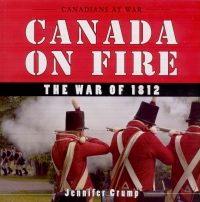| ________________
CM . . . . Volume XVII Number 33 . . . . April 29, 2011
excerpt:
Canada on Fire is a new account of the War of 1812-14 between the United States of America and the British colonies of Upper and Lower Canada. War is never dull, and the story of this war, a David and Goliath affair with an outcome few would have predicted, has much to make it interesting. It has heroes and villains, trickery and bravado and battles aplenty. This version by Jennifer Crump is well-researched and historically accurate. Her written account of the war, however, does not always agree with the chronological history, and this can be confusing. For example, Chapter 1 deals with General Sir Isaac Brock and the Battle of Queenston Heights. This battle came after the British capture of Fort Michilimackinac, the subject of Chapter 2. The two events are properly placed in the accompanying Chronology so the chapter order is a little odd. Canada on Fire is well illustrated with 25 interesting black and white drawings and period maps which are spread throughout the book. The book contains an Index, Chapter Notes, lists of Primary and Secondary Sources and the Chronology of important dates. In addition, a number of sidebars are used to good advantage. One of these, "Secrets and Spies" shows how easy and uncomplicated espionage was in the 19th century. While the period maps are interesting, they do not provide much insight into the vast scale of the conflict. It would have been helpful to have a map of North America (minus Mexico) to show where all of the battles and skirmishes took place. The War of 1812-14 was fought over a very large area, but this isn't obvious from the maps in the book. The interested reader will have to look up the places mentioned in an atlas to find this out. There are a number of things mentioned in Canada on Fire that readers may find confusing. In the British army, it was the custom for sons of the aristocracy to buy their commissions. This is what is meant by the statement "FitzGibbon....had earned his way through the ranks by recognition rather than an exchange of coin." A footnote explaining this would have been welcome. Footnotes could also have been used to explain why the Wyandot (a tribe of native people) were considered "a senior nation" and what is meant by "a hero of Culloden." Readers will also be puzzled by the statement, "While Canadian privateers harried the east coast and the British Navy maintained a tight blockade on the Atlantic coast, it was the Americans who dominated the inland water." They are the same coast. Even more confusing is the following: "American goods bought at Halifax made their way across the Pacific to supply the British troops fighting Napoleon or were loaded onto ships and sent down the St. Lawrence River for the use of British and Canadian soldiers fighting the Americans in Upper Canada." Surely, what was intended was the Atlantic and up the St. Lawrence. There is one error in the use of tenses. Crump wrote "Captain Porter's force slipped into the forest....where they could not be seen by Norton's snipers." The next sentence reads, "They proceed up both sides of the river until they surround one of Norton's groups..." The past tense should be used in the second sentence. Jennifer Crump, the author of Canada on Fire, has written several other books for young people, including Amazing Stories and Frommer's Toronto With Kids. She has also written articles for Canadian Geographic and Reader's Digest magazines. Her writing style is suitable for young readers who will find Canada on Fire an exciting book, but, because of the mistakes, it is only recommended with reservations for classroom work. Recommended with reservations. Thomas F. Chambers, a retired college teacher, lives in North Bay, ON.
Native people in 1812 were not known as First Nations people.
To comment
on this title or this review, send mail to cm@umanitoba.ca.
Copyright © the Manitoba Library Association. Reproduction for personal
use is permitted only if this copyright notice is maintained. Any
other reproduction is prohibited without permission.
NEXT REVIEW |
TABLE OF CONTENTS FOR THIS ISSUE
- April 29, 2011.
AUTHORS |
TITLES |
MEDIA REVIEWS |
PROFILES |
BACK ISSUES |
SEARCH |
CMARCHIVE |
HOME |
